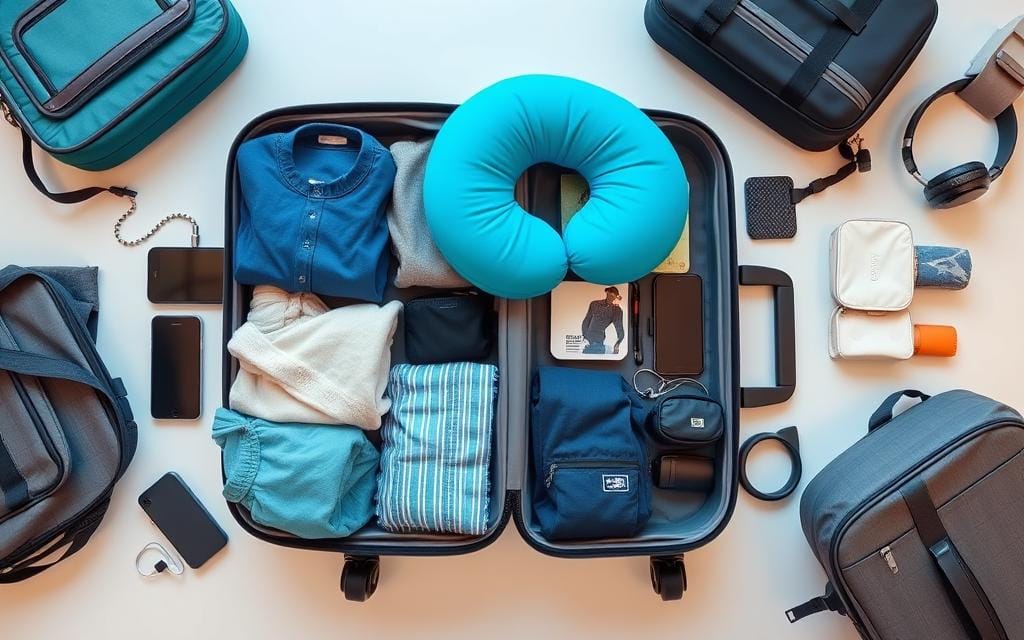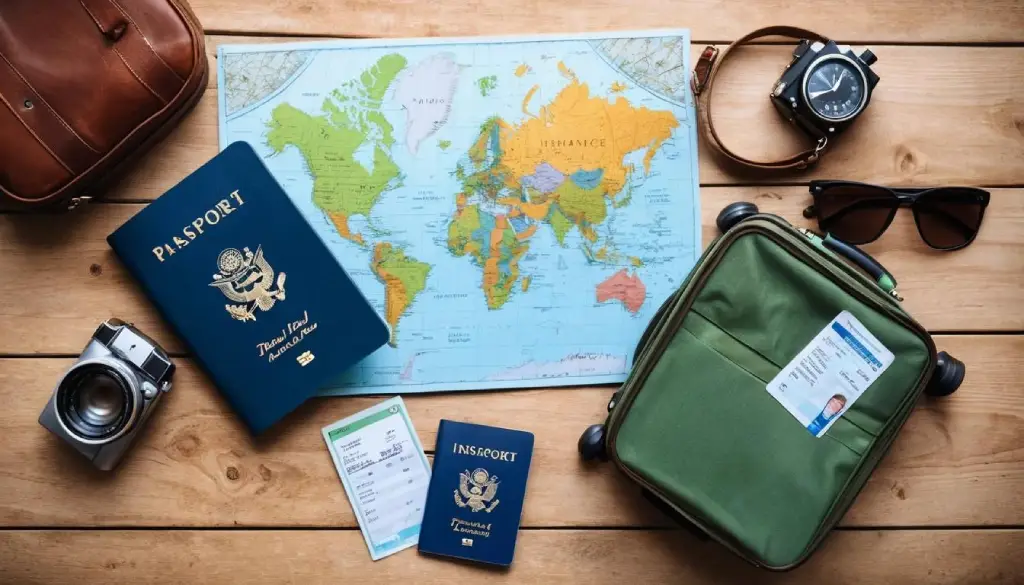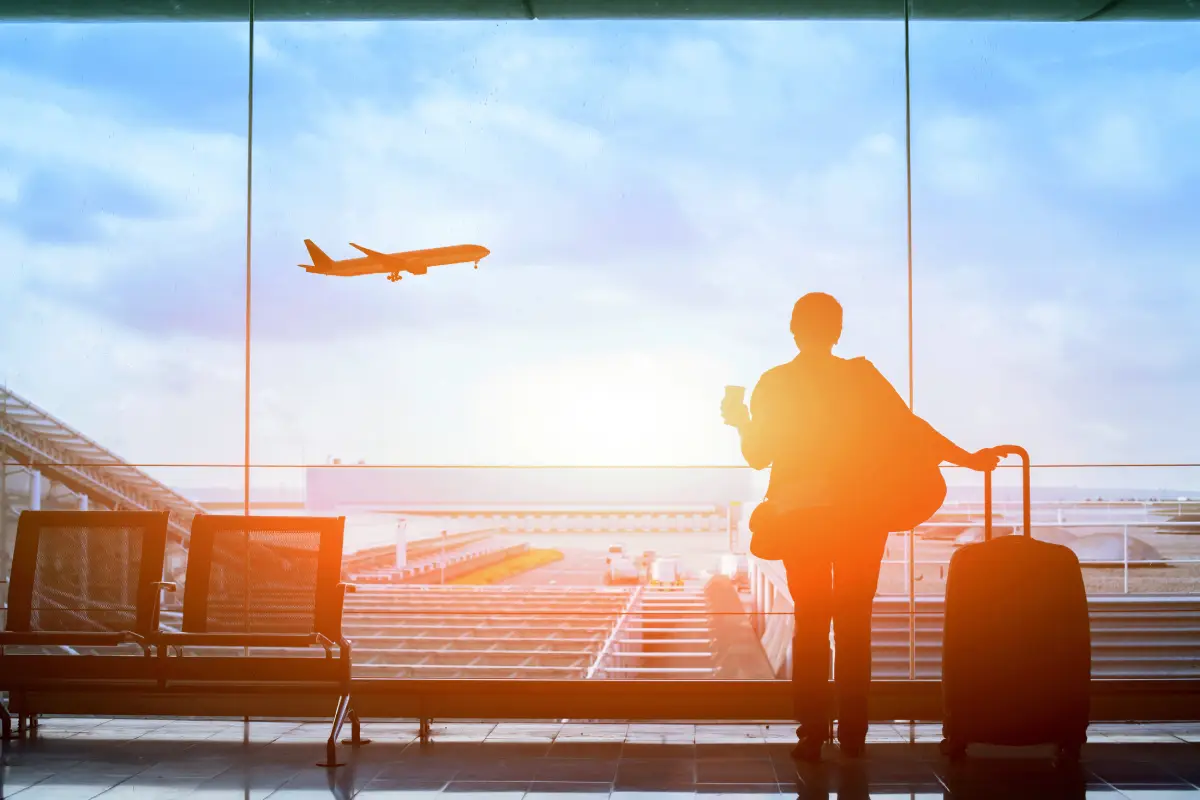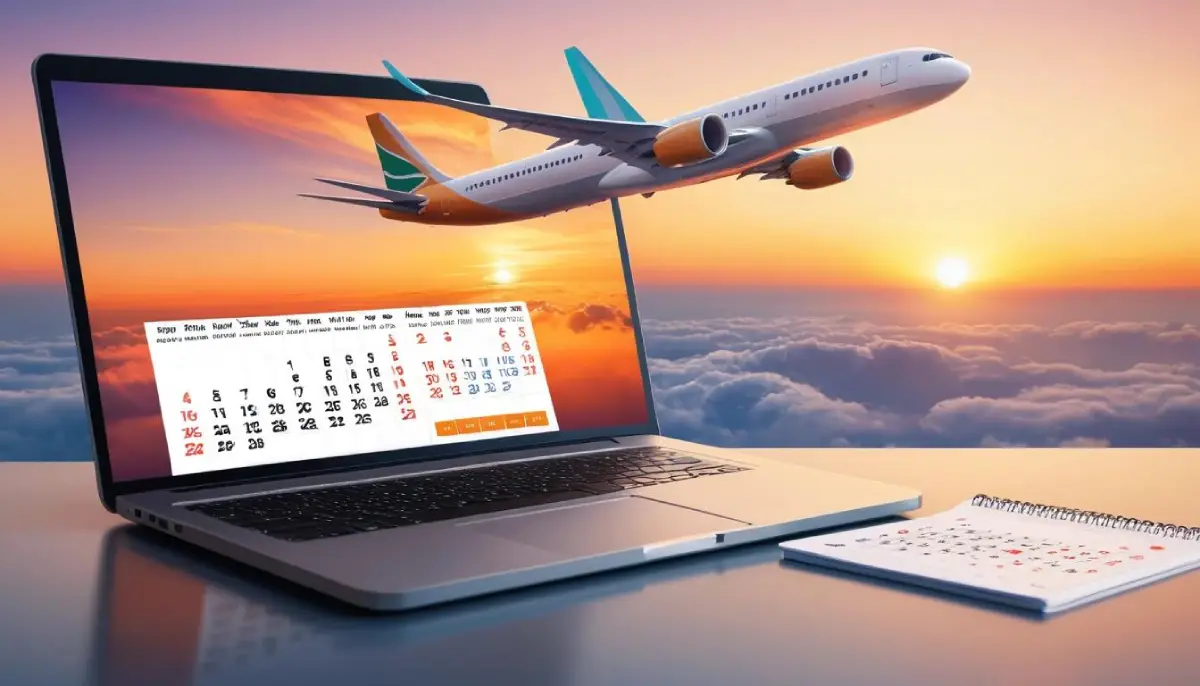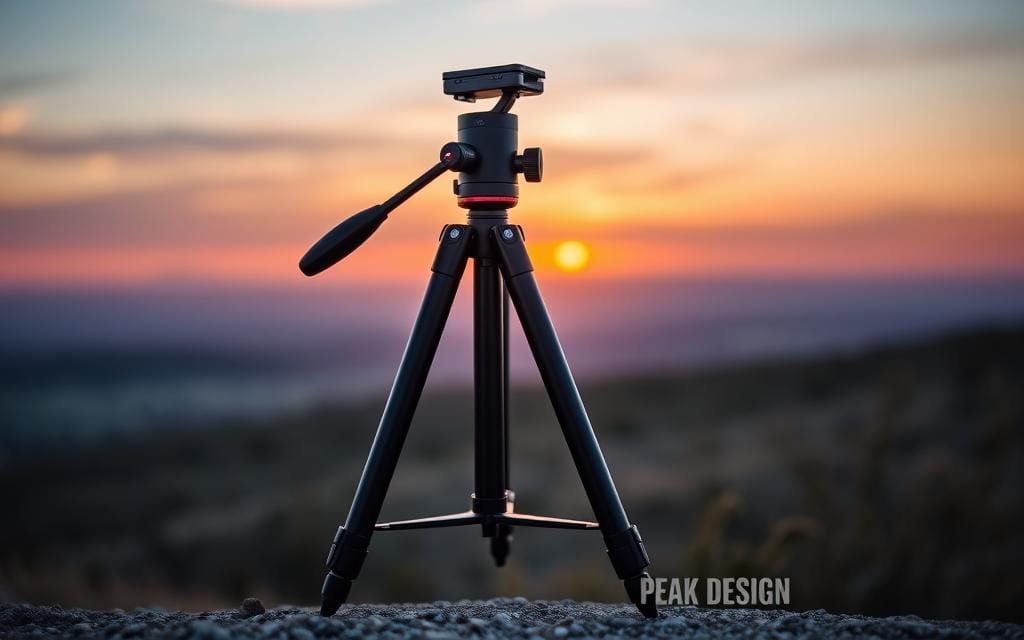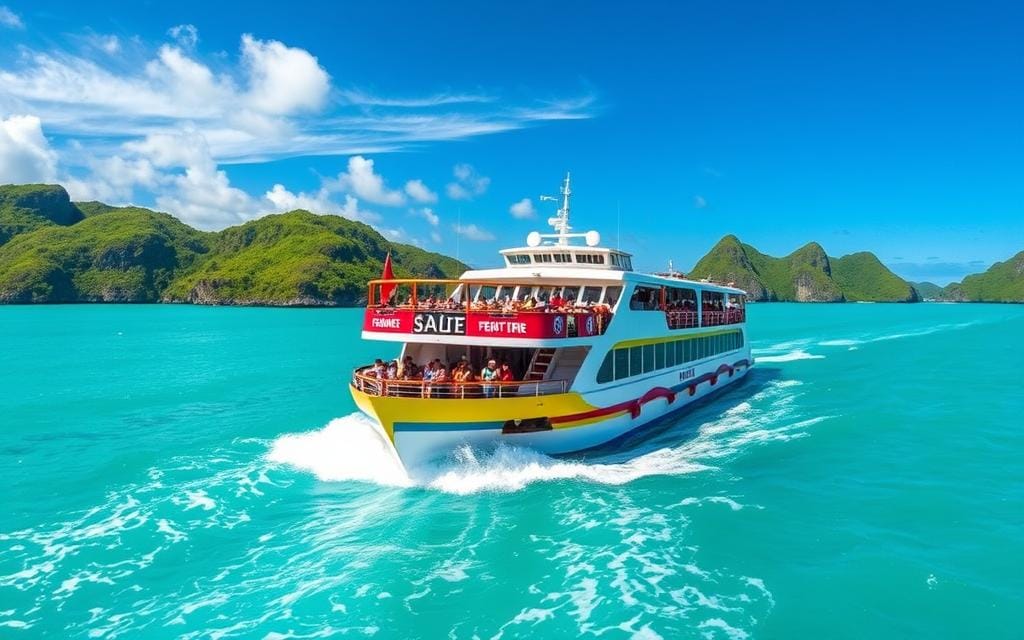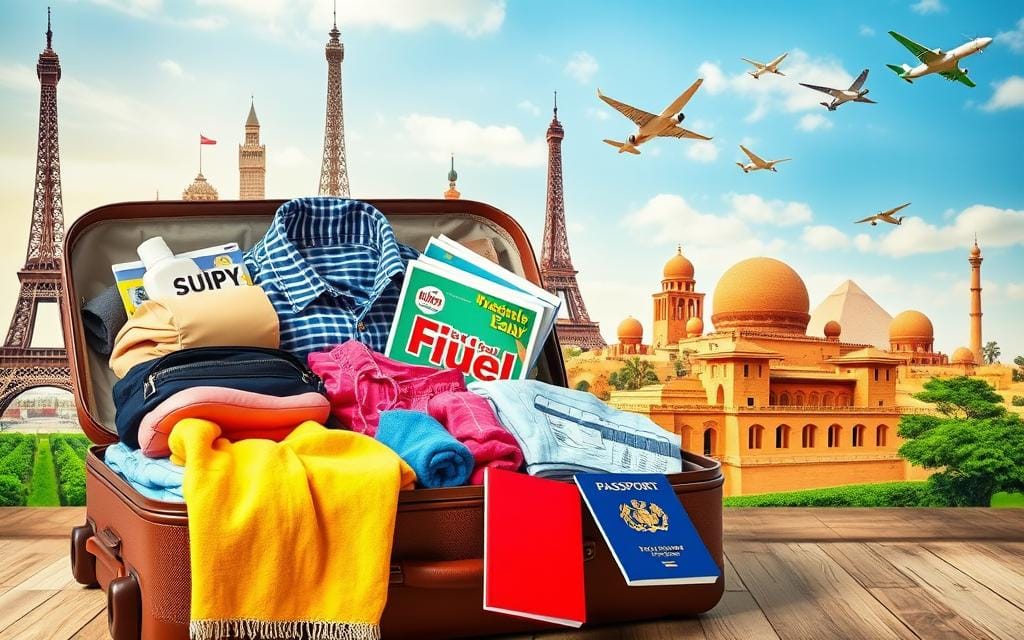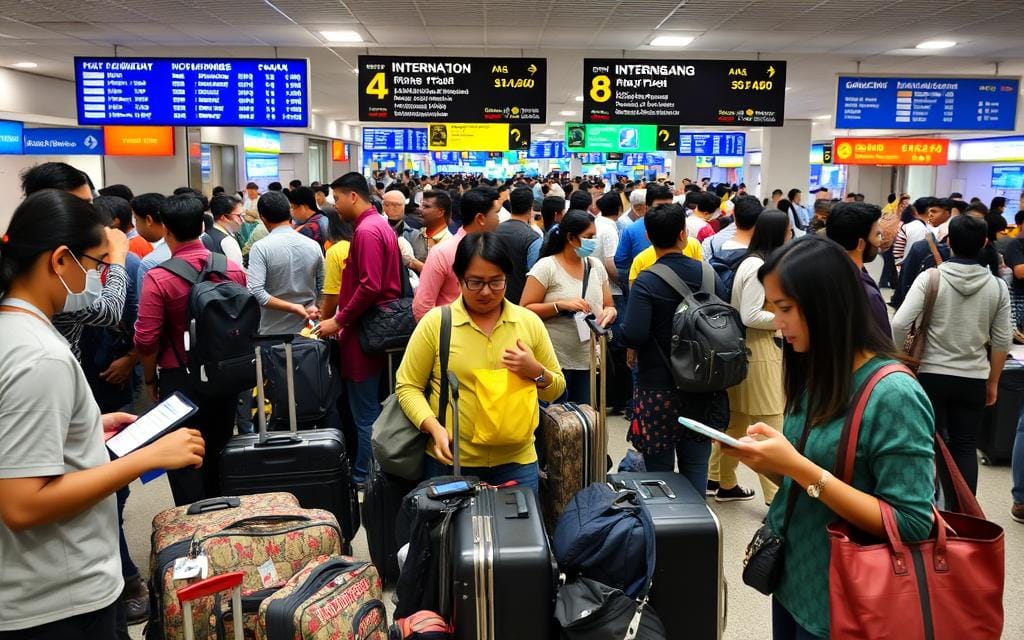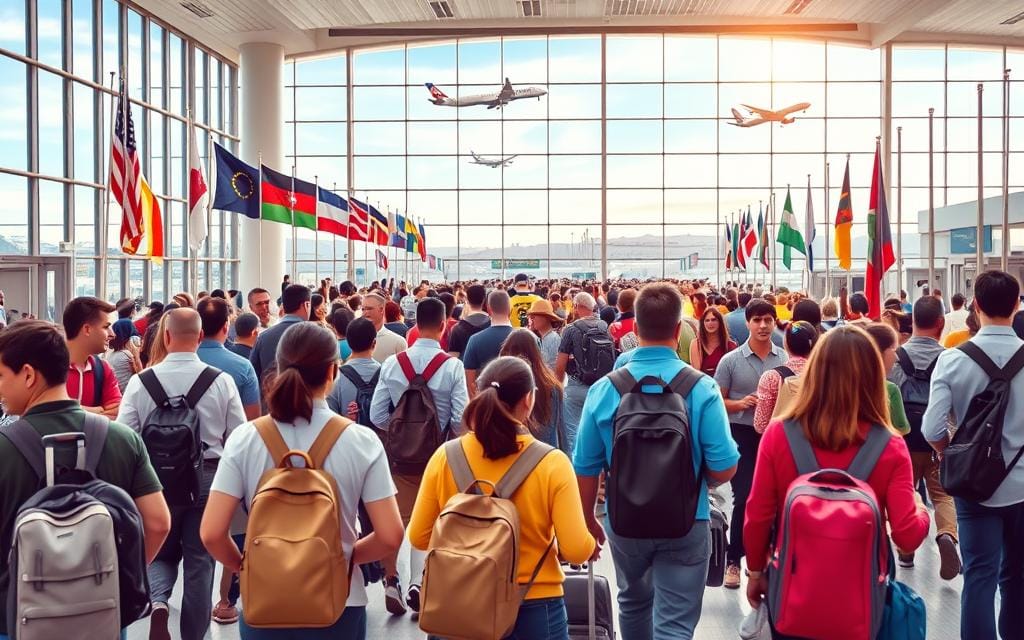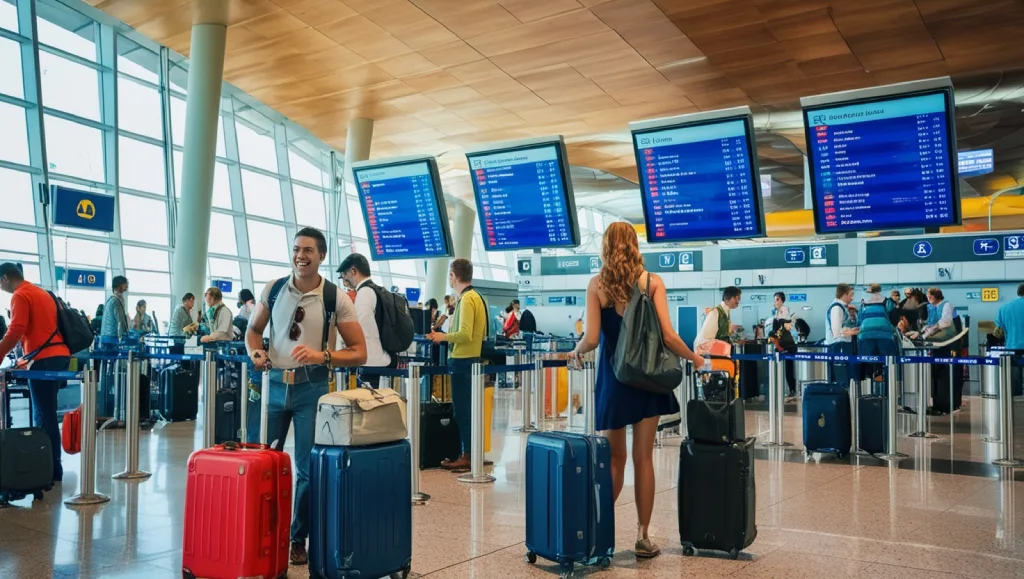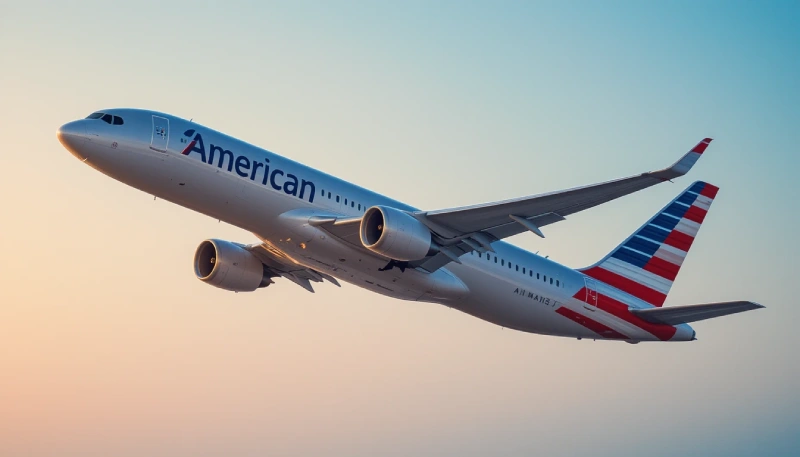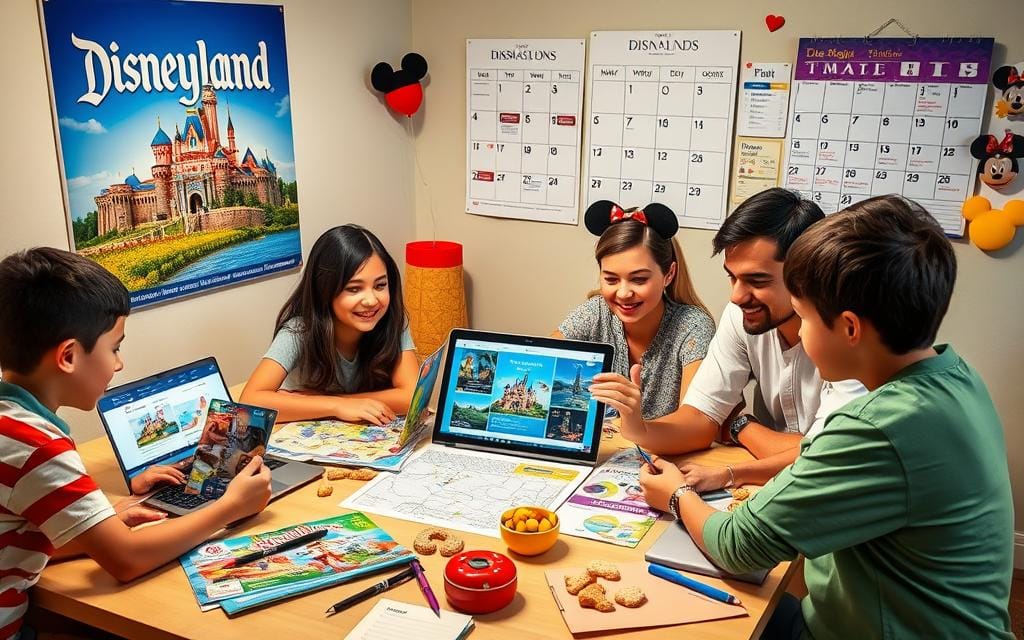Discover the best packing tips for carry on luggage to save space, stay organized, and breeze through your next trip with ease and efficiency.
Imagine making your travel experience better by mastering packing carry-on luggage. I’ve learned that packing light is crucial for a smooth trip. With airline rules changing often, knowing the best packing tips is key to avoid extra fees and enjoy your trip more.
Getting ready for my next trip, I wonder if packing carry-on luggage can be easy. The answer is yes, with a good guide that covers all you need to know. By packing light and using the best tips, you’ll travel without stress and enjoy every moment.
With the right strategies and packing tips, traveling becomes easy. You’ll make the most of your journey and create lasting memories.
Let’s explore the world of stress-free travel and find the best packing tips for carry-on luggage that will change your travel experience forever.
Table of Contents
ToggleUnderstanding Carry-On Regulations and Size Limits
Before you pack, know the carry-on rules and size limits of your airline. Each airline has its own set of rules. It’s important to check with your airline before your trip. Knowing these rules helps avoid problems at check-in.
Most airlines allow bags up to 22 inches tall, 14 inches wide, and 9 inches deep. But, some airlines might have tighter size limits. Also, remember that weight matters, as some airlines have specific weight limits for carry-on bags.
Different Airline Requirements
Some airlines have special rules for liquids and electronics. Always check with your airline before your trip. For example, some airlines might only allow liquids in containers of 3.4 ounces or less. Others might have specific rules for electronics packaging.
Weight Restrictions to Know
Weight limits for carry-on bags vary among airlines. Some allow bags up to 40 pounds, while others are stricter. Make sure your carry-on meets your airline’s weight limit before your trip.
| Airline | Size Limits | Weight Restrictions |
|---|---|---|
| American Airlines | 22 inches tall, 14 inches wide, 9 inches deep | 40 pounds |
| Delta Air Lines | 22 inches tall, 14 inches wide, 9 inches deep | 35 pounds |
| United Airlines | 22 inches tall, 14 inches wide, 9 inches deep | 40 pounds |
Prohibited Items List
Also, check your airline’s list of banned items. These can include sharp objects, firearms, and certain batteries. Knowing this list helps you avoid trouble at check-in.
Essential Items You Should Never Leave Behind
When packing your carry-on, some items are must-haves. These can greatly improve your travel experience. I always pack my passport, phone charger, wallet, and any needed meds in my carry-on.
I also bring a spare set of clothes. This is in case my checked luggage is delayed or lost. Other must-haves include a travel adapter, a portable power bank, and noise-canceling headphones. These keep you connected, entertained, and comfortable.
Here are more items to consider for your carry-on:
- A travel-sized toiletry bag with toothbrush, toothpaste, and other essentials
- A snack or two, like nuts or dried fruit, to keep hunger at bay
- A book or e-reader for downtime and relaxation
- Earplugs or an eye mask for better sleep
By packing these items, your travel can be more comfortable and enjoyable. Always check with your airline for any specific packing rules before you go.
My Pre-Packing Checklist for Success
Travel planning starts with a pre-packing checklist. It makes your trip smooth and stress-free. A good packing list is key to a great travel experience. Start by thinking about how long you’ll be away and what you’ll do.
Your checklist should cover clothes, toiletries, electronics, and travel documents. Don’t forget to check the weather for your destination. For example, cold places need warm clothes, and sunny spots need swimwear and sunscreen.
Creating a Master Packing List
Begin by listing the essentials you need to pack. This includes:
- Clothing and shoes
- Toiletries and personal care items
- Electronics and chargers
- Travel documents and insurance
Weather Considerations
Always check the weather forecast before you go. This helps you pack the right clothes and gear. Think about the season, climate, and any weather that might impact your trip.
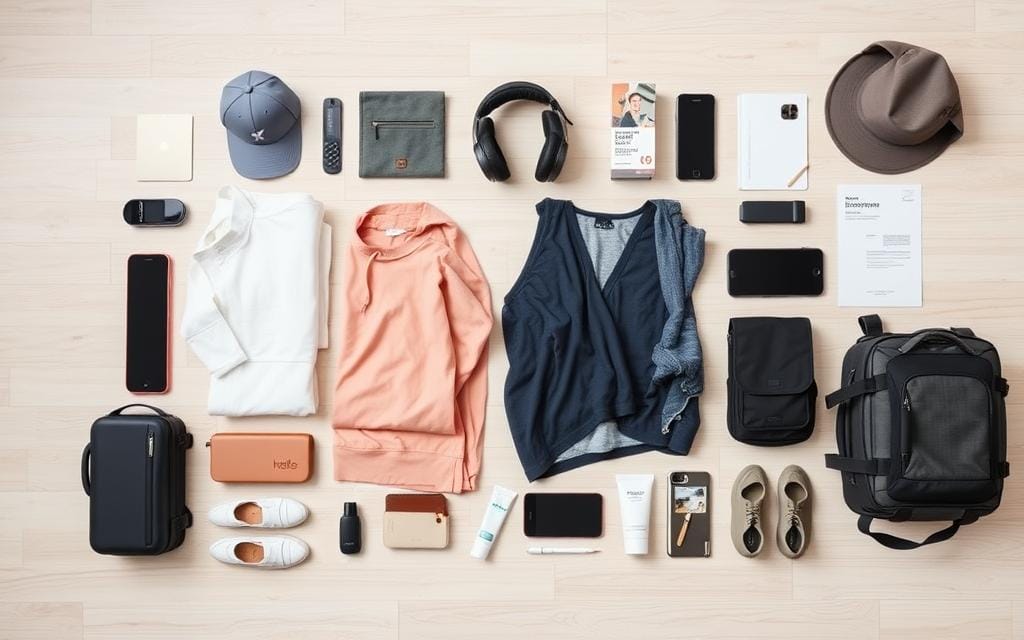
Duration-Based Planning
Consider how long you’ll be away when packing. Longer trips need more clothes and toiletries. Short trips require less. A well-thought-out checklist ensures a successful and fun trip.
Best Packing Tips for Carry On Luggage That Changed My Travel Game
I’ve learned a lot about packing carry-on luggage efficiently. Packing cubes have been a game-changer for me. They help compress clothes and items, making the most of space. With packing cubes, I’ve mastered some top packing tips for carry-on luggage, making travel easier and more convenient.
Wearing my heaviest or bulkiest items, like my coat or boots, on the plane saves space. This trick is one of my favorite travel hacks. It lets me pack more essentials in my carry-on. Other useful travel hacks include:
- Rolling clothes to save space and reduce wrinkles
- Packing a portable charger to keep devices charged
- Using a travel wallet for organized documents
By using these packing tips, I’ve made the most of my carry-on luggage. These tips are great for both seasoned and new travelers. They help you pack like a pro and use your carry-on luggage efficiently.
With practice and patience, you can pack carry-on luggage like a pro. This makes travel more convenient and stress-free. Try these travel hacks and see how they can improve your travel experience.
The Roll vs. Fold Debate: Which Method Works Best
The debate on packing clothes with rolls or folds is ongoing. Both methods have their pros and cons. Rolling is great for compressing clothes and reducing wrinkles, perfect for t-shirts and socks. Folding is better for formal wear or delicate fabrics to prevent creases and damage.
Using both rolling and folding can optimize your packing space. This way, you can organize your clothes better and use your luggage space wisely. Choose the best technique based on the fabric and the item’s purpose.
Rolling Technique for Different Fabrics
The rolling technique works well for casual wear and items that can be compressed. For example:
- T-shirts and tank tops
- Socks and underwear
- Lightweight pants and shorts
Folding Strategies for Formal Wear
Folding is better for formal wear and delicate fabrics. It prevents creases and damage. It’s ideal for items like:
- Suits and dresses
- Blouses and dress shirts
- Delicate lingerie and accessories
Mastering the roll vs. fold debate can enhance your packing skills. Using a mix of both techniques can make your luggage space more efficient. This ensures your clothes stay organized and arrive in good condition.
Space-Saving Compression Techniques
To make the most of my carry-on space, I’ve discovered some great compression methods. Packing cubes are a favorite of mine. They keep clothes organized and help pack more into my luggage. For bulky items like jackets, I use compression bags.
Rolling my clothes is another space-saving trick I’ve mastered. It works best when paired with packing cubes. This way, I can pack more while keeping everything tidy. I also fill any empty spots in my luggage with small items like socks.
Other ways to save space include:
- Using vacuum-seal bags to compress clothes and other items
- Wearing bulky items like jackets or boots on the plane to save space in my luggage
- Using a packing list to ensure I only bring essential items and avoid overpacking
By using these techniques, I’ve managed to fit everything into my carry-on. This saves me time at the airport and reduces the chance of lost or damaged luggage.
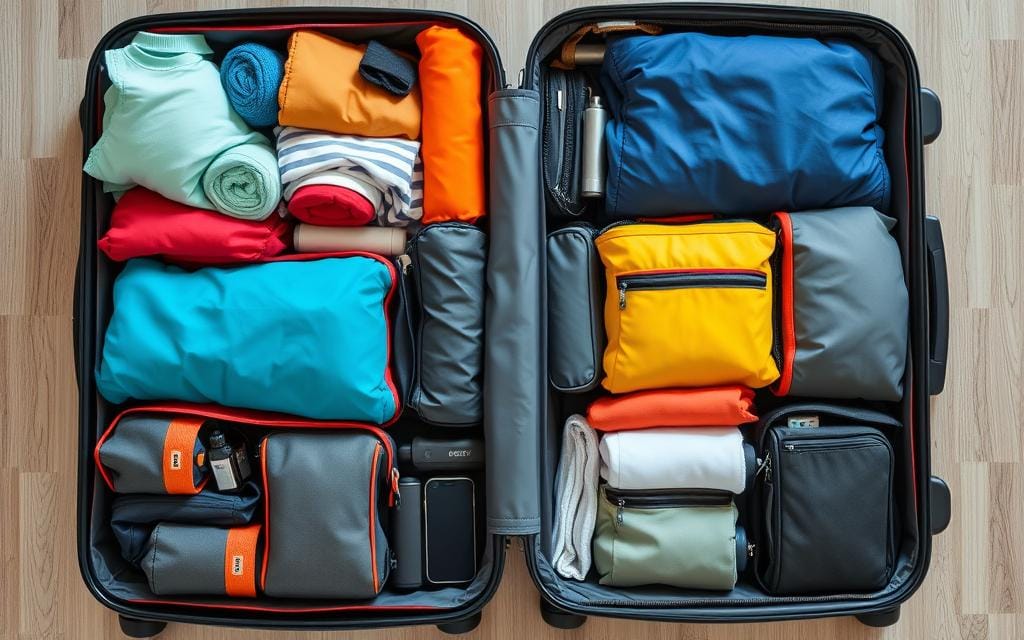
Overall, these space-saving methods have changed my travel routine for the better. Being smart about what I pack and how I pack it makes my trips more efficient and stress-free.
Organizing Electronics and Cables
When packing your carry-on luggage, it’s key to keep your electronics and cables in order. Use a dedicated pouch or bag for this. It keeps your devices and cables neat. This makes it easy to find what you need fast.
For cable management, think about using cable ties or cord organizers. These tools keep your cables from tangling and getting damaged. Good cable management is vital for a stress-free travel experience.
Tech Essentials Organization
Here are some tips for organizing your tech essentials:
- Use a portable power bank to keep your devices charged
- Pack a set of charging cables, including USB-C and Lightning cables
- Consider using a travel adapter to stay charged on the go
Charging Solutions
Pack a portable power bank to keep your devices charged. It’s a must-have for long trips without a power outlet. Choose a power bank that’s small, light, and can charge your devices many times.
Protection Methods
Use protective cases or sleeves for your electronics. They prevent damage from drops and scratches. Look for cases that are tough but light, offering good protection for your devices.
By following these tips, you can keep your electronics and cables organized. This ensures you have everything to stay connected while traveling. Good electronics organization and cable management greatly improve your travel experience, keeping you productive and entertained.
| Electronics | Cable Management | Tech Essentials |
|---|---|---|
| Smartphone | Cable ties | Portable power bank |
| Laptop | Cord organizers | Travel adapter |
| Tablet | USB-C cables | Charging cables |
Liquid Items and TSA Requirements
When packing your carry-on luggage, knowing the TSA’s rules for liquids is key. The 3-1-1 rule says liquids, gels, and aerosols must be in containers of 3.4 ounces or less. These containers must fit in a clear, quart-sized zip-top bag. This rule is vital for the safety of all passengers.
To pack smart and follow the rules, here are some tips:
- Choose multi-purpose liquid items to reduce the number of containers you need to pack.
- Opt for solid or powder alternatives when possible, such as solid shampoo or powder toothpaste.
- Be mindful of the size and type of containers you use, as they must comply with the TSA requirements.
Some items, like toiletries and medications, might not follow these rules. But, it’s best to check with the TSA before your trip. This way, you can avoid any issues during security screening.
For more info on the TSA’s 3-1-1 rule and other travel rules, visit the TSA website. Knowing the latest TSA requirements helps you move through security smoothly. It also lets you use your carry-on luggage space better.
| Liquid Item | Container Size | Special Considerations |
|---|---|---|
| Toiletries (e.g., shampoo, conditioner) | 3.4 ounces or less | Must be in a clear, quart-sized zip-top bag |
| Meds | Varies | May be exempt from the 3-1-1 rule, but check with the TSA |
| Food and drinks | Varies | Check with the TSA for specific travel regulations and restrictions |
Maximizing Personal Item Space
To make the most of your travel, it’s key to use your personal item space well. This means packing smart and using the right travel accessories. Use packing cubes or organizers in your purse or backpack to keep things neat and within reach.
These tools help you pack more efficiently. They make your personal item space better organized. This means you can find what you need fast, saving you time and stress. Travel accessories like packing cubes, travel wallets, and phone cases with card slots are great for this.
Strategic Personal Item Packing
Think about what you’ll need to grab quickly when packing your personal item. Items like your phone, wallet, and travel documents should go in easy-to-reach spots. This makes airport security checks and grabbing things on the go much easier.
Quick-Access Essentials
Here are some essentials to pack in your personal item for quick access:
- Phone and portable charger
- Wallet and travel documents
- Headphones and a travel adapter
- Snacks and a refillable water bottle
Packing these items in easy spots helps you move smoothly through airports and your travels. Choose travel accessories that match your style and needs. Get creative with your packing to make the most of your personal item space.
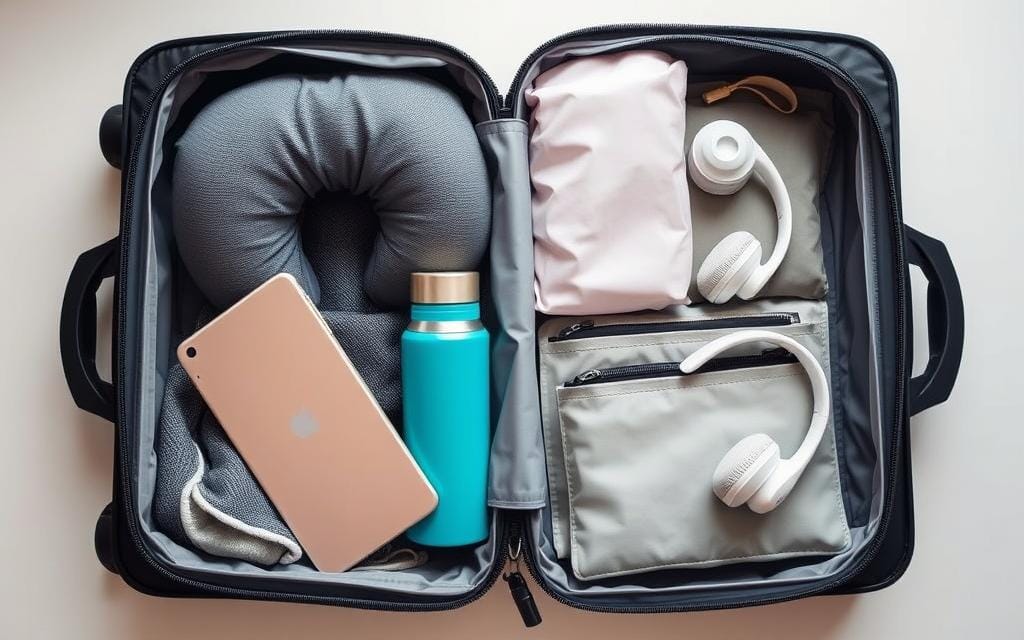
Smart Clothing Choices for Minimal Packing
Packing for a trip can be easier if you choose clothes that can be mixed and matched. This way, you can create many outfits with just a few pieces. It’s all about picking versatile items for a stylish and efficient travel wardrobe.
Building a travel wardrobe starts with a simple color scheme. Neutrals like black, white, and gray are perfect. They can be dressed up or down and go with many colors. Pack items like dresses, skirts, and pants that can be worn in different places.
Versatile Wardrobe Selection
Choosing the right clothes is key for packing light. Here are some tips for your travel wardrobe:
- Opt for clothing items that can be easily mixed and matched
- Focus on a limited color palette to simplify outfit creation
- Pack multipurpose items like dresses and skirts that can be worn in different settings
Mix-and-Match Strategies
Get creative with your outfits by using the same pieces in different ways. A dress can be worn alone or with a jacket for a formal look. This way, you need fewer pieces and pack lighter.
By using these strategies, you can have a travel wardrobe that’s both useful and stylish. It makes traveling easier and more fun. The secret is to choose versatile and simple clothes, so you can pack light and still look great.
Emergency Items to Include
When packing your carry-on luggage, it’s key to include emergency items. These items can help in unexpected situations. They are a vital part of your travel essentials.
A first aid kit is a must-have in your carry-on. It helps treat minor injuries. Include band-aids, antiseptic wipes, pain relievers, and any personal medications you need.
- Band-aids and bandages
- Antiseptic wipes and spray
- Pain relievers, such as acetaminophen or ibuprofen
- Any personal medications that you may need
Other emergency items to pack include a small flashlight and a portable charger. Also, bring a set of warm clothing for unexpected delays or changes in your travel plans.
By packing these emergency items, you’re ready for any situation. Always check TSA requirements for carry-on items like liquids or sharp objects.
Being prepared and packing the right emergency items makes your trip safe and stress-free. You can then focus on the travel essentials that matter most to you.
| Emergency Item | Description |
|---|---|
| First Aid Kit | A kit that includes band-aids, antiseptic wipes, and pain relievers |
| Flashlight | A small flashlight that can provide light in case of a power outage |
| Portable Charger | A charger that can charge your phone or other devices on the go |
Conclusion: Mastering the Art of Carry-On Packing
Looking back, I see that mastering carry-on packing is a skill that grows with time. It’s about finding the right ways to pack efficiently and reduce stress. This guide has shown you how to improve your travel experience.
It’s crucial to know your airline’s rules and size limits for carry-ons. Make sure to pack important items like your passport, phone charger, and any medications.
With these tips, you’ll soon become a pro at packing light. Stay organized and use smart packing tricks to make the most of your luggage.
By using these travel tips, you’ll travel with ease and confidence. Whether you’re a seasoned traveler or new to it, learning to pack well is key. Next time you pack, take a few minutes to plan your carry-on strategy. You’ll be happy you did.
Want to pack smarter for your travels? Visit wanderstayfinder.com for the best packing tips for carry-on luggage and make your journey hassle-free today!
FAQ
What are the best packing tips for carry on luggage to avoid checked baggage fees?
To avoid checked baggage fees, learn to pack your carry-on luggage well. Know the carry-on rules and use packing cubes. Wear your heaviest items on the plane.
Use space-saving tricks like rolling clothes or using compression bags. This helps you use your carry-on space better.
How do I determine the size limits for my carry-on luggage?
To find out your carry-on size limits, check with your airline first. Each airline has its own rules. Knowing these rules helps you avoid problems at check-in.
What are some essential items that I should never leave behind when packing my carry-on luggage?
Don’t forget important items like your passport, phone charger, and wallet. Also, pack a change of clothes and a travel adapter. Noise-canceling headphones can make your trip more comfortable.
How can I create a pre-packing checklist to ensure I don’t forget anything important?
Start a pre-packing checklist with a list of everything you need. Think about the weather and how long you’ll be away. Use a packing list template or a travel app to stay organized.
What is the 3-1-1 rule for liquid items in carry-on luggage, and how does it affect my packing?
The 3-1-1 rule means liquids must be in 3.4-ounce containers. These go in a clear, quart-sized zip-top bag. Use travel-sized toiletries or decant liquids to follow this rule and pass security checks.
How can I maximize my personal item space and pack strategically?
Use packing cubes or organizers to keep things tidy. Put essentials like your phone and wallet in easy-to-reach spots. A personal item bag with many pockets helps you stay organized.
What are some smart clothing choices for minimal packing, and how can I create a versatile wardrobe?
Choose clothes that can be mixed and matched for many outfits. Opt for a versatile wardrobe with items like dresses and skirts. Stick to a color palette like neutrals to create different outfits with fewer pieces.
What are some emergency items that I should include in my carry-on luggage?
Include emergency items like a first aid kit and pain relievers in your carry-on. Also, pack a small emergency kit with band-aids and a flashlight. These are useful in unexpected situations.

